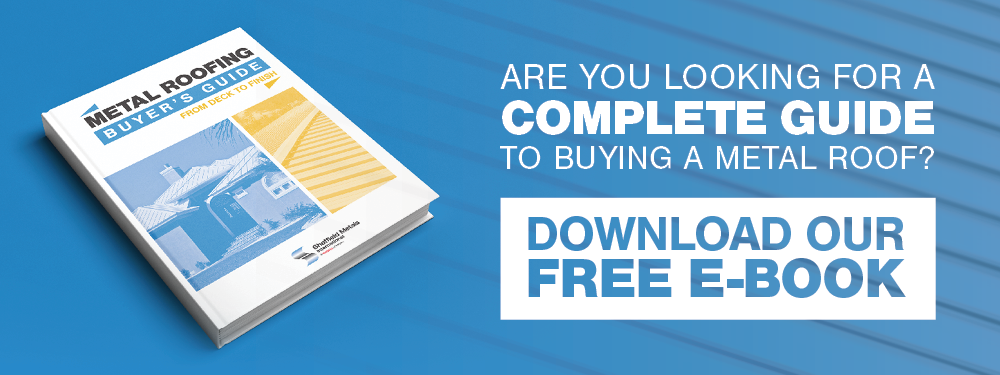If you’re looking to purchase a metal roofing system, there are many different material options — aluminum, copper, zinc, galvanized, stainless steel, and Galvalume®.
The most widely used metal in architectural metal roofing is Galvalume, a steel-based product that can be used for nearly every building application.
How much do you know about Galvalume? Do you know the critical advantages and disadvantages of this metal roofing material?
Our primary product offerings at Sheffield Metals are painted and bare Galvalume coils and sheets used in the architecturally-driven metal roof and wall industry. We know how important it is for you to be an educated buyer, so let’s dive into the specific details of this material and why it may or may not be a good choice for your project.
Ahead in this article, we cover:
- What is Galvalume?
- Uses for Galvalume
- Advantages of Galvalume
- Disadvantages of Galvalume
What Is Galvalume®?
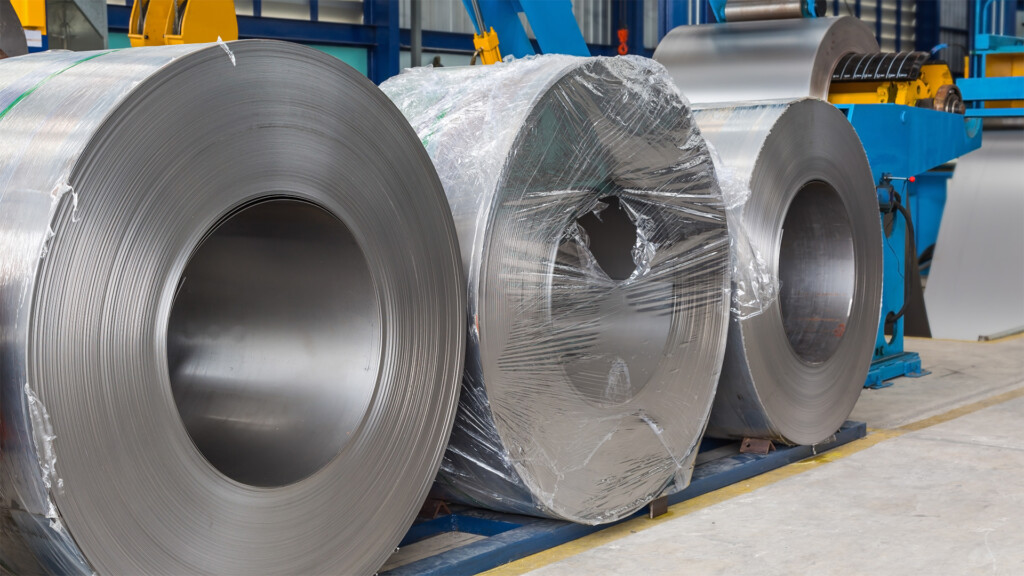
Bethlehem Steel introduced the Galvalume coating to the construction industry in the early 1970s. Before Galvalume came into existence, most metal roofing was galvanized steel. However, because of the superior durability and corrosion resistance of Galvalume, 90+ percent of the metal roofing industry transitioned from galvanized substrates to a Galvalume substrate in the mid to late 1990s.
Galvalume combines three of the most high-performing and important metals used in roofing today — steel, aluminum, and zinc. Manufacturers begin with a cold-rolled carbon steel base sheet that is continuously hot-dipped with aluminum and zinc alloys (AZ) until it reaches a coating of 55% aluminum, 43.4% zinc, and 1.6% silicone.
This process allows for one material to have some of the best characteristics of each metal, which is why it’s become one of the most popular metals used in metal roofing.
Galvalume may also be referred to by its coating weights, AZ-50 and AZ-55. Here’s a quick breakdown of what these two terms mean:
- AZ-50 = 0.50 ounces per square foot of the aluminum-zinc alloy coating applied to both sides of the substrate.
- AZ-50 is the typical coating weight for painted sheet and coil products.
- AZ-55 = 0.55 ounces per square foot of the aluminum-zinc alloy coating applied to both sides of the substrate.
- AZ-55 is the typical coating weight for bare or unpainted (often called acrylic-coated Galvalume or Galvalume Plus) sheet and coil products.
- Acrylic-coated Galvalume has a slightly heavier coating weight and includes a light acrylic coating that protects the Galvalume coating in the manufacturing process. This acrylic coating will wear off over time with exposure. Though not painted, these products still need to be handled with care, or you risk scuffing or perforating the coating.
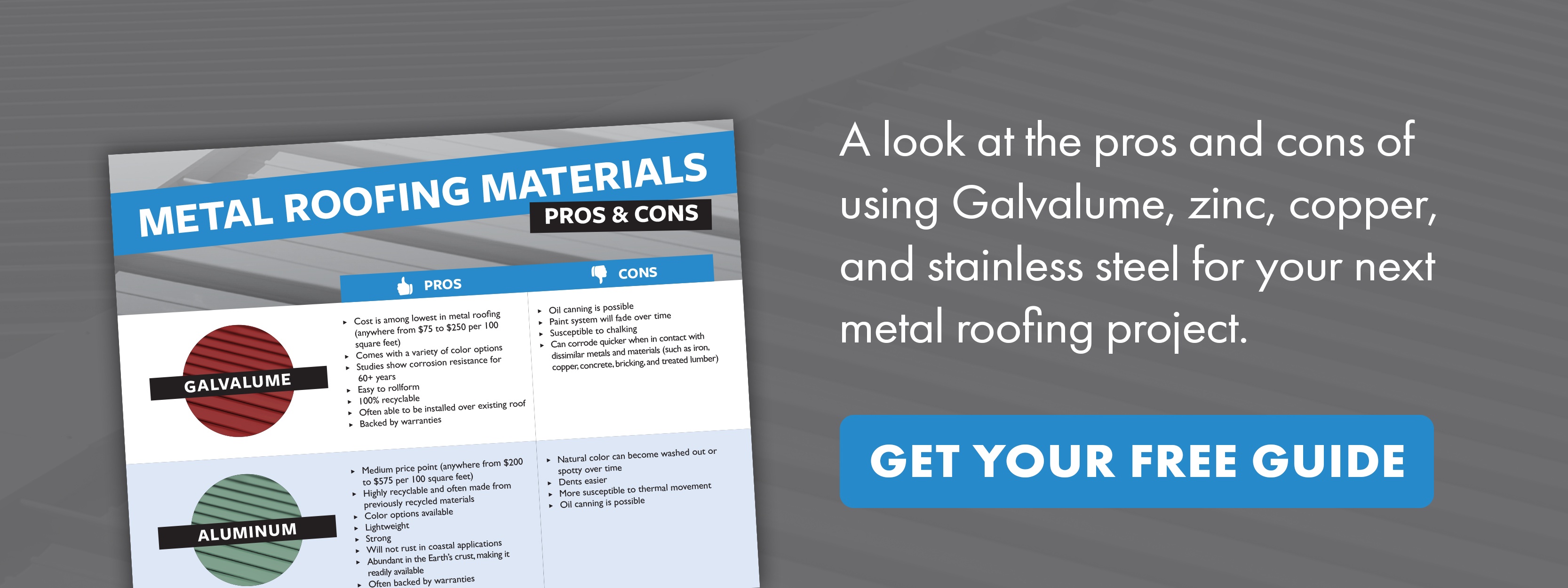
Uses for Galvalume® Metal Roofs & Walls
Overall, Galvalume is suitable as a roof, wall, trim, accent, and more in most building applications in some of the most extreme environments, including non-coastal hurricane zones, locations with high rain or snowfall, high-temperature regions, and more.
Some common uses for Galvalume include:
- Commercial buildings – Hospitals, schools, stores, government buildings, and more
- Residential projects – Single-family, multi-family, condominiums, and more
- Architectural structures – Commercial, governmental, residential, and more
- Structural or industrial applications – Warehouses, factories, and more
- Agricultural – Non-animal confinement spaces, barns, storage, and more
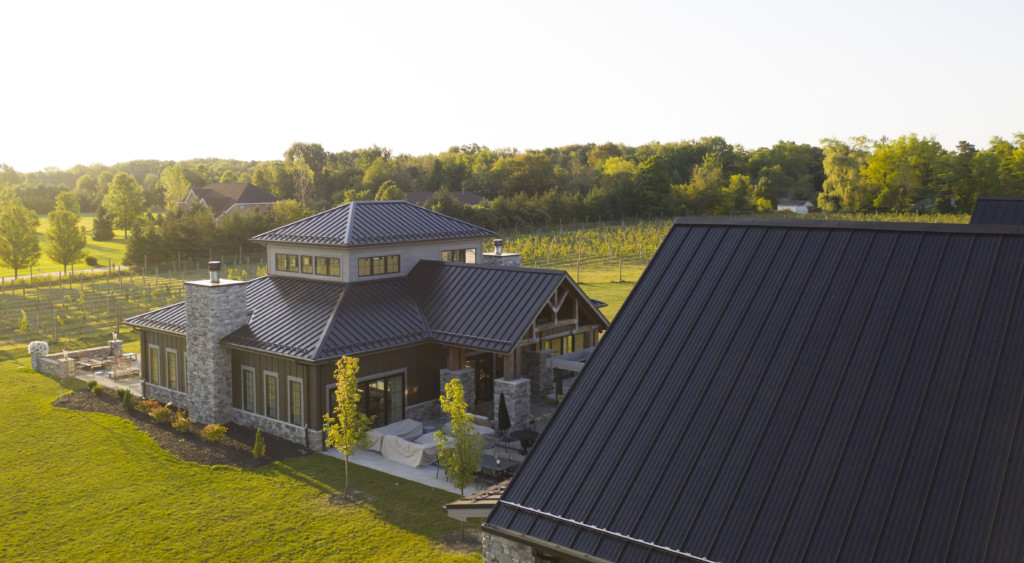
However, there are some situations where Galvalume is not recommended for use. In most of these situations, the primary concern is that the aluminum-zinc coating will prematurely break down and cause the system to fail quicker than if it were not in that location.
Here are a couple of circumstances where Galvalume should not be used:
- Animal enclosures or buildings – Galvalume is not suitable for use on buildings where animals are housed or held. Manure from the animals breaks down into ammonia gas over time and then reacts with the Galvalume coating. This process breaks down the Galvalume coating and leads to degradation of the metal. However, Galvalume is sometimes used on modern chicken houses built with a vapor barrier between the chicken area and the roof for appropriate ventilation. It’s best to check with the manufacturer before putting Galvalume on an animal confinement building, as it’s often dependent on the specific design and use.
- Coastal environments – The coating of Galvalume will not stand up to the conditions associated with a coastal environment, including properties up against breaking surfs, large bays, marshes, and other coastlines. Specifically, large amounts of salt will degrade the Galvalume coating and lead to premature damage to the roof or wall. It’s recommended that properties within a certain distance of a coast use an engineered aluminum roof system, as aluminum resists corrosion and rusting from saltwater for much longer.
If your project is in one of these environments or you’re unsure if your location is corrosive to Galvalume, it’s best to check with the manufacturer to see what they recommend.
Advantages & Benefits of Galvalume® Metal Roofing
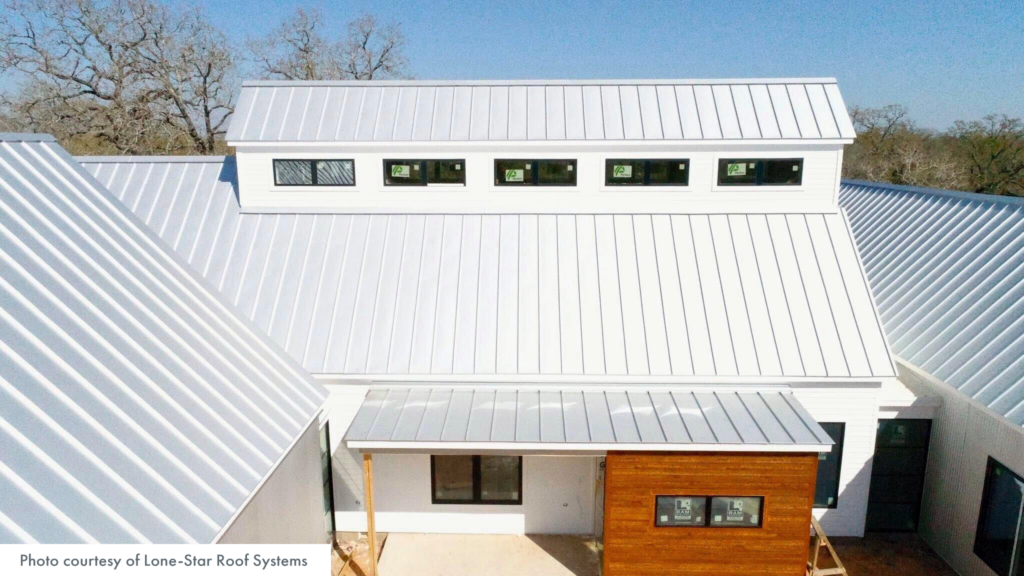
Warrantied Product
One of the number one selling points of Galvalume is the 25.5-year warranty on the substrate, which is sometimes referred to as a perforation warranty. Galvalume systems also often come with paint warranties that further protect your investment and provide peace of mind that the roof or wall system will last. (Note: Substrate or paint warranties are NOT available for Galvalume products within 1,500 feet of a coast.)
Plus, commercial property owners can buy a weathertight warranty for their Galvalume roofing structure, which ensures the roof was installed correctly and adheres to strict installation details.
Corrosion Resistance & Self-Healing Properties
Galvalume’s chemical formula was specifically designed to combine the toughness, strength, and self-healing properties of zinc with the rust resisting properties of aluminum. That’s why Galvalume’s corrosion resistance is about two to four times better than galvanized steel.
Galvalume’s self-healing characteristics help control the red rusting at any cut/exposed edges. Nearly all steel-based products will experience some level of normal edge creep from the exposed steel when the coil is cut, but it is minimal and will eventually stop with Galvalume. Remember that edge creep can also be offset by hemming the panels and touching up any exposed edges with paint pens.
Additionally, these self-healing characteristics make failure in the roof field less likely with Galvalume systems.
Easy to Handle & Install
Another benefit of Galvalume is that it’s not as temperamental as other metals used in the roofing industry, like copper and zinc. Installers don’t have to worry as much about leaving fingerprints, deep scratches, etc., on panels because Galvalume is tougher and a little more tolerable. It also doesn’t have many strict ventilation or air gap requirements like some other metals.
Plus, Galvalume is a standard metal roofing product and doesn’t have too many special requirements, which allows the installation details to be pretty standard across the board.
Even though it’s a tough material, installers still find Galvalume easy to handle, rollform, cut, and beyond.
Longevity
Research indicates that Galvalume roofing could last as long as 50+ years in the right environment without any extreme corrosion. This makes Galvalume an excellent choice for home and property owners looking to buy a roofing system that won’t need to be replaced every 10-15 years, like asphalt shingles.
Economical & Competitively Priced
For the most part, Galvalume is reasonably priced and one of the most affordable metal materials available for roofing products. Depending upon the thickness, color, and quality of the desired Galvalume panels, pricing ranges anywhere from $5.00 to $15.00 per square foot. Keep in mind that in 2021 and 2022, steel prices are continually fluctuating, so the price can vary dramatically.
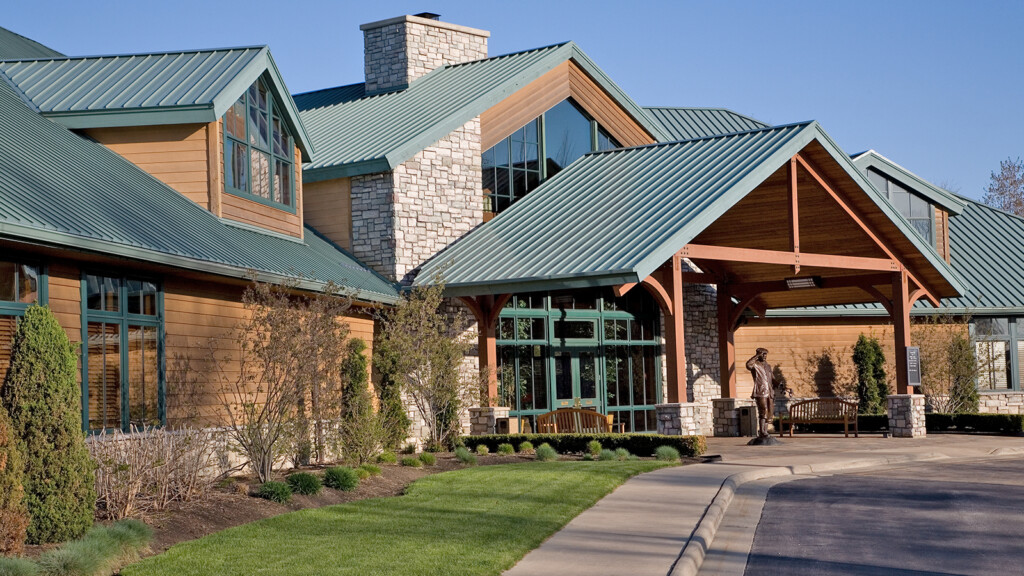
Disadvantages & Cons of Galvalume®
Oil Canning
Oil canning is an inherent characteristic of light-gauge, cold-formed metal products, especially products with broad flat areas. It is a visual phenomenon seen as waviness or distortion in the flat surfaces of metal panels. Luckily, oil canning is only an aesthetic concern that does not affect the strength or performance of the system. This occurrence is possible with any metal roof or wall type, including Galvalume.
However, there are methods to minimize the appearance of oil canning, including:
- Purchasing a thicker sheet or coil product (22 vs. 24 vs. 26-gauge).
- Buying trustworthy brands of coils and sheets.
- Rollforming panels with striations or bead stiffeners in the flat area of panels to minimize the appearance of oil canning.
- Hiring an experienced contractor who knows the best material handling and installation practices that help reduce oil canning.
- Ensuring there are no roof decking issues, as the metal will follow any inconsistencies on the deck. So, if the roof deck is not in plane, consider fixing it beforehand to reduce the risk of oil canning.
Interactions with Other Materials
Combining different metals on a metal roof system can lead to interactions that could result in early degradation, staining, and potential failure of a system altogether.
Galvalume performs best when not in contact with copper, lead, bricks, treated lumber, iron, and concrete. If Galvalume is in contact with one of these and is then introduced to an electrolyte such as water, it can lead to galvanic corrosion of the metal.
Unpainted Galvalume Can Scuff Easier
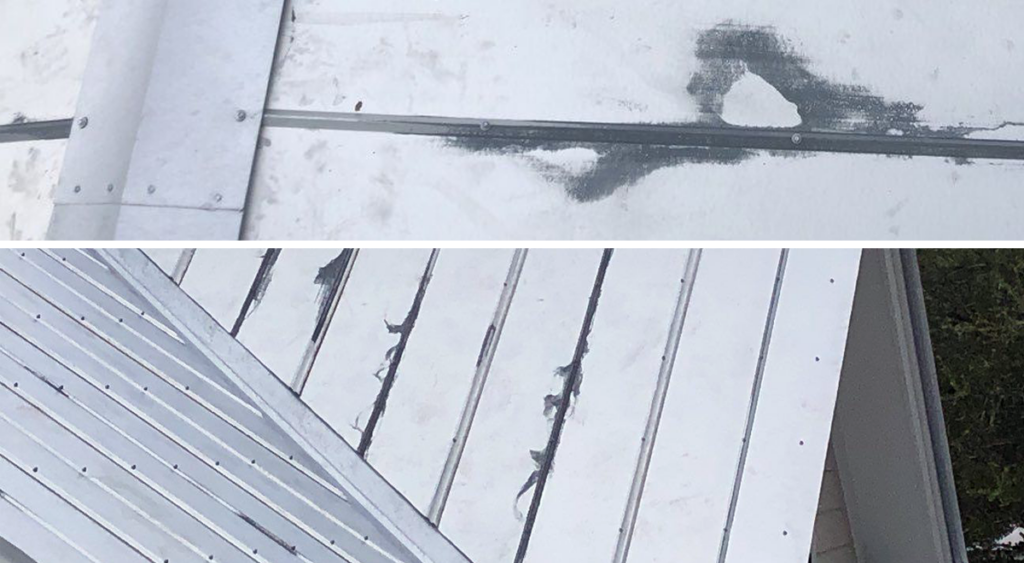
One of the considerations that contractors should remember when installing non-painted Galvalume is that you can scuff off the acrylic coating in high-traffic areas. Once the coating is scuffed, there’s not much that can be done to fix the issue other than immediately replacing the scuffed panels. If scuffed unpainted Galvalume is left on the roof, it may become splotchy as the scuffed/exposed parts of the roof age and weather quicker.
When installing unpainted Galvalume, it’s best to:
- Limit the foot traffic on newly installed panels.
- Be aware of ladder placement.
- Refrain from pivoting or pressing shoes/boots down too hard on the installed panels.
Final Thoughts on Galvalume® Metal Roofing
Galvalume is an excellent option for many metal roofing projects, but it’s still important to know when it should and shouldn’t be installed.
To recap what we’ve covered:
- Galvalume is a material formulated to last for decades in the right environment.
- Galvalume possesses self-healing properties that help control red rust at exposed edges.
- Galvalume is easy to handle, tolerable, and doesn’t have extensive special installation requirements.
- Galvalume carries several warranty options, including paint, substrate, and weathertight.
- Note: Weathertight warranties are only available for commercial applications.
- Galvalume should not be used in coastal environments or on animal enclosure structures.
Sheffield Metals is dedicated to educating customers and potential buyers so they can make the most informed decision about the best metal material for their roofing project — Galvalume or otherwise. Whether you’re a contractor, architect, manufacturer, property owner, or beyond, we can work with you to choose the right product for your project(s).
Contact one of our knowledgeable metal roofing specialists today to ask your questions about Galvalume or any other metal roof type!
